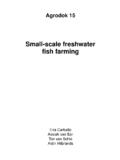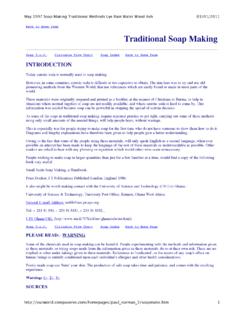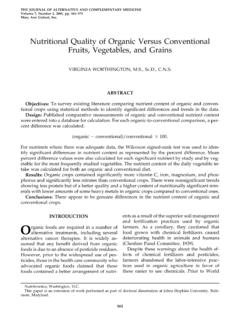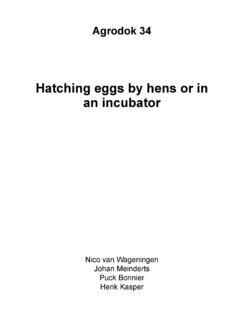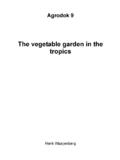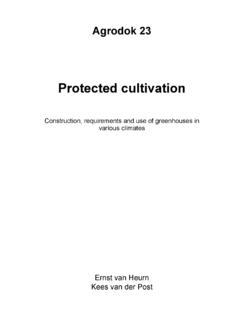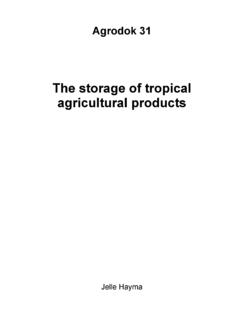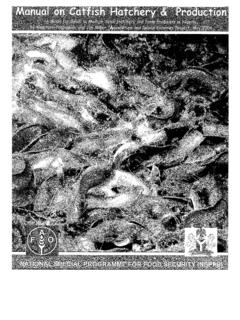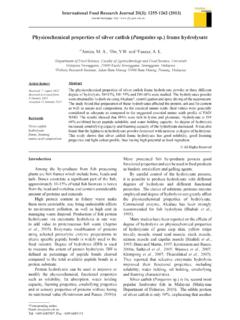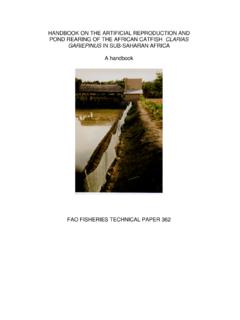Transcription of Raising catfish in a barrel - Journey to Forever
1 1 Philip Mahan demonstrates how a fish is transferred from the fry tank to the catfish in a barrelA biological food chain in the back yard produces fresh fish for the table and compost for the Philip and Joyce MahanThe text and photographs of this article are from Organic Gardening and Farming, November, 1973 After some study and experimentation, we have set up a productive food chain-- table scraps to earthworms to catfish --in our back yard. The project is satisfactory in many respects, utilizing waste materials to produce fresh fish for food and at the same time yielding ample compost for a small garden.
2 The material cost is minimal. The whole operation can be set up for less that $ The equipment occupies only about 12 square feet of space, and the entire assembly can be easily moved if necessary. 2 The materials can be very simple: Two 55-gallon steel drums, three panes of glass 24 inches square, and a medium-sized aquarium air pump. One of the drums will serve as a tank for the fish, oxygen being supplied by the air pump; and the second drum should be cut in half to provide two bins for the worms.
3 The panes of glass are used as covers for the worm bins and fish tank, and for ease and safety in handling can be framed with scrap chose catfish because they are readily available in our part of Alabama, and reach eating size in a summer. Various small members of the sunfish family, such as bluegill or bream, would also be we readily admit that our plan has no commercial possibilities, we know that we can produce, for our own table, tasty fresh fish that is uncontaminated and costs practically nothing, both considerations being highly relevant at this are usually efficient food producers; a one-pound fish yields approximately 10 ounces of food.
4 Further efficiency is indicated by the fact that fish fed on commercial fish ration convert about 85 percent of their food to meat. While we are not prepared to compute the technical data about food conversion in fish on an earthworm diet, we can readily state that the fish relish earthworms, and do grow well on this the water back into the tank aerates the water and at the same tie releases the ammonia produced by excretory matter in the water. Because the oxygen requirements of fish are quite high, the faster the circulation of the water, the faster the growth of the decided to keep our equipment as simple and inexpensive as possible at the beginning, but to use the maximum stocking density advised, keeping 40 fish in a 55-gallon drum.
5 Although inexpensive circulation pumps are available, we chose to use a METAFRAME HUSH II aquarium bubbler for oxygenation and a garden hose to siphon off water from the bottom of the take off 15 gallons of water per day, but as we run the waste water onto the worm beds and adjacent garden, the cost is negligible. Although we have creek water close at hand, we were advised to use city water to avoid the introduction of undesirable algae and fungi that might be harmful to the fish. Because city water is usually quite highly chlorinated, it is necessary to draw the water in 5-gallon buckets and let it stand for a day in the sun before emptying it into the drum to replace the water siphoned off.
6 We have seen no evidence of oxygen starvation in the fish with this method of water most important variable we have found is water temperature. catfish will feed at temperatures as low as 40 or 45 degrees, but their greatest growth is achieved at 84 degrees. We noticed a decided increase in feeding activity when we painted the barrel black and moved it into full sun. Leaving the buckets of water in the sun not only speeds chlorine dissipation, but warms the water as well. In areas where city water temperatures are close to the growth optimum, the chlorine can be removed by setting the hose nozzle at fine spray, and the barrel can then be filled directly from the water supply.
7 Although summer growth is greatest, the project continues throughout the year. By judicious use of sun when possible, plus auxiliary heat when necessary, winter growth can be kept at a fairly high water temperatures are right, the fish will feed so enthusiastically that they may leap completely out of the barrel . For this reason the top of the barrel should be covered completely with a pane of glass which will also help in keeping the water warm. Because fish feed most eagerly in late evening and early morning, we feed them at these times of the day.
8 As with earthworms, care must be taken not to overfeed. In warm water and bright sunlight, any uneaten worms will die and decompose rapidly, giving off gases which are poisonous to the any grown animal to a confining environment produces the equivalent of cultural shock, and is followed by a period when feeding is light and growth is slow. At this time special care must be taken not to overfeed. Unless fish can be found that have been hatched and grown in a tank, small fish should be selected to stock the barrel , as their adaptation time is proportionally shorter that that of larger fish.
9 To eliminate as much transplanting shock as possible, we use a large wooden box, lined with two layers of polyethylene sheeting and covered with an old door, to stock with fry. By the time the fry reach fingerling size, they can be transferred to the barrel as replacements are needed, and very little shock is evident. An insect lamp over an opening in the cover of the fry tank permits the small fish to eat at night while ridding the garden of night-flying , as any angler knows, are food for fish in their natural habitat; and most fish in captivity prefer live food to the dehydrated type.
10 Kitchen scraps make excellent food for earthworms, and even the most careful organizer will have enough refuse to feed, quite handsomely, 5,000 to 10,000 found that growing earthworms at home is not difficult. The basic materials are easily arranged, and the earthworms' demands are simple. All they require are a protective container, reasonable temperature control, adequate moisture, not too much 4food, and a light loose bedding which is never allowed to become 55-gallon drum to the right is for Raising fingerlings to eating size.
